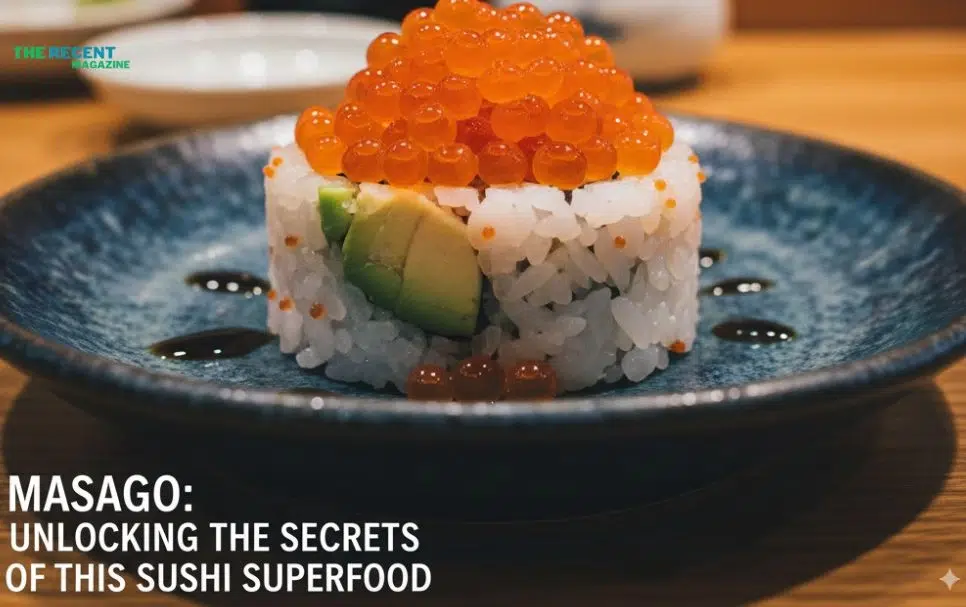Now Reading: Masago: Unlocking the Secrets of This Sushi Superfood
-
01
Masago: Unlocking the Secrets of This Sushi Superfood
Masago: Unlocking the Secrets of This Sushi Superfood

Have you ever wondered what gives sushi that delightful pop of texture and flavor? Meet Masago the tiny, vibrant orange eggs from the capelin fish that can transform your sushi experience.
Whether you’re a sushi lover or someone curious about Japanese cuisine, understanding Masago can open up a world of taste and creativity in your meals. You’ll discover what Masago is, how it tastes, its health benefits, and simple ways you can enjoy it at home.
Ready to add a burst of flavor and a touch of elegance to your dishes? Keep reading to unlock the secrets of Masago!
What Is Masago
Masagois the small, orange eggs of the capelin fish. It is used a lot in Japanese food, especially on sushi. The word “masago” means “fish eggs” in Japanese. These eggs add a crunchy texture and a mild salty taste to dishes.
Masago comes from the capelin fish, which lives in cold ocean waters. The fish lay many tiny eggs, which are collected and cleaned to make masago. It is less expensive than other fish eggs.
| Feature | Masago | Caviar |
|---|---|---|
| Source | Capelin fish | Sturgeon fish |
| Price | Affordable | Expensive |
| Flavor | Mild, salty, slightly sweet | Strong, rich, complex |
| Use | Garnish for sushi and seafood | Luxury delicacy, eaten plain or with blinis |
Flavor Profile
Masagohas a mild, slightly salty tastewith a hint of sweetness. It also carries a lightly bitter and briny flavorthat adds complexity without overpowering dishes. The texture is crunchy and small, creating a pleasant mouthfeel.
It pairs well with soy sauce, wasabi, and pickled ginger, balancing its taste with sharp and spicy notes. Masago also complements seafood like squid and salmon, enhancing their natural flavors. Many enjoy it on sushi, sashimi, and rice bowlsto add color and texture.
Nutritional Benefits
Masagois rich in proteinand omega-3 fatty acids, which support brain and heart health. It also contains vitamins B12 and D, important for energy and bones. Masago has low caloriesand fat, making it a light addition to meals.
This fish roe can help improve metabolismand boost the immune system. Its antioxidantsprotect cells from damage. Eating masago may support healthy skinand vision.
Some people might face allergic reactionsto fish eggs. Masago can have high sodium, which is not good for blood pressure. It might also contain trace contaminantsfrom the fish environment. Moderation is key to enjoy masago safely.
Culinary Uses
Masagois often used in sushi and sashimi to add color and texture. It has a crunchy textureand a mild, salty flavorthat pairs well with raw fish. Chefs sprinkle it over rolls or sashimi for a bright orange garnishthat looks appealing.
In recipes, masago can be mixed with mayonnaise and spices to create a creamy sauce. This sauce is spread on sushi rolls or used as a dip. Some creative dishes include masago-topped avocado toast or salads, adding a unique seafood twist.
Masago also works well in Asian-inspired pasta or rice bowls. Its small eggs add bursts of flavor and a pop of color. Using masago in different ways can make simple dishes more interesting and tasty.
Buying And Storage
Masagois usually found in Asian grocery storesand sushi markets. Freshness matters most. Check the expiration dateon the package. Frozen masago lasts longer and keeps its flavor better. Many stores sell it in small containers or vacuum-sealed packs.
Store masago in the coldest part of the refrigerator, ideally below 40°F (4°C). Use it within a week for best taste. If frozen, thaw slowly in the fridge before use. Avoid refreezing as it harms the texture and taste. Keep the container tightly sealed to stop air and moisture from spoiling it.

Sustainability And Environmental Impact
The capelin fish populationis key to masago supply. Overfishing can reduce their numbers quickly. Sustainable fishing helps keep the population healthy and stable. Fish farms that follow eco-friendly methods reduce harm to wild capelin. These methods include catching only what is needed and avoiding damage to ocean habitats.
Choosing eco-friendly masagosupports ocean health. Look for labels like MSC (Marine Stewardship Council) certification. This shows the product comes from responsible fisheries. Sustainable masago helps protect the environment and ensures future availability. Consumers can help by buying from trusted sources that follow strict rules.
Frequently Asked Questions
What Is Masago?
Masago is the roe (eggs) of the capelin fish, used as a colorful, mildly salty topping in Japanese cuisine, especially sushi.
Is Masago A Caviar?
Masago is fish roe from the capelin fish, but it is not considered true caviar. Caviar typically comes from sturgeon and is more luxurious. Masago serves as an affordable, colorful garnish in sushi, differing in flavor and texture from traditional caviar.
What Does Masago Taste Like?
Masago tastes mildly salty, slightly sweet, and briny with a subtle citrusy and fishy flavor. It has a delicate crunch.
Is Masago Healthy?
Masago is healthy in moderation. It provides protein, omega-3 fatty acids, and vitamins but can be high in sodium.
Conclusion
Masago offers a unique taste and texture to many dishes. Its small, crunchy eggs add color and flavor. People enjoy it in sushi, salads, and more. Masago is affordable and easy to find. It brings a mild, salty, and slightly sweet flavor.
Including masago in meals adds variety and interest. Try it to explore new tastes and textures. Masago remains a popular choice in Japanese cuisine worldwide. Our all updete get to visit our website: therecentmagazine






















